

Ars Antiqua. The Medieval Classroom. History of the Gregorian Chant Gregorian Chant takes its name from Pope Gregory I also known as Gregory the Great.
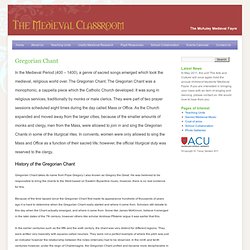
He was believed to be responsible to bring the chants to the West based on Eastern Byzantine music, however, there is no real evidence for this. Because of the time lapsed since the Gregorian Chant first made its appearance hundreds of thousands of years ago it is hard to determine when the Gregorian Chant really started and where it came from. Scholars still debate to this day when the Chant actually emerged, and where it came from. Some like James McKinnon, believe it emerged in the later dates of the 7th century, however others like scholar Andreas Pfisterer argue it was earlier that this. 100 Years of Church Teaching on Gregorian Chant. In 2003, Pope John Paul II commemorated first centenary of the promulgation of Pope Saint Pius X’s motu proprio on sacred music, Tra le Sollecitudini.
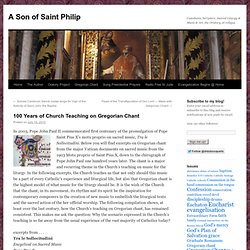
Below you will find excerpts on Gregorian chant from the major Vatican documents on sacred music from the 1903 Motu proprio of Saint Pius X, down to the chirograph of Pope John Paul one hundred years later. The chant is a major and recurring theme in the Church’s teaching on music for the liturgy. In the following excerpts, the Church teaches us that not only should this music be a part of every Catholic’s experience and liturgical life, but also that Gregorian chant is the highest model of what music for the liturgy should be. Gregorian chant. From New World Encyclopedia The Introit Gaudeamus omnes, scripted in square notation in the fourteenth—fifteenth century Graduale Aboense, honors Bishop Henry, patron saint of Finland.
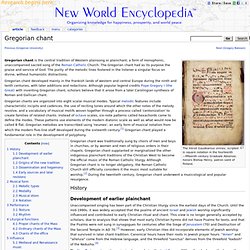
Define Gregorian chant at Dictionary. Gregorian Chant. Help support New Advent and get the full contents of this website as an instant download.
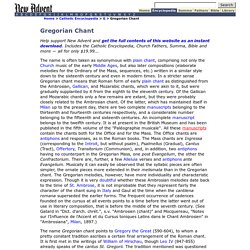
Includes the Catholic Encyclopedia, Church Fathers, Summa, Bible and more — all for only $19.99... The name is often taken as synonymous with plain chant, comprising not only the Church music of the early Middle Ages, but also later compositions (elaborate melodies for the Ordinary of the Mass, sequences, etc.) written in a similar style down to the sixteenth century and even in modern times. In a stricter sense Gregorian chant means that Roman form of early plain chant as distinguished from the Ambrosian, Gallican, and Mozarabic chants, which were akin to it, but were gradually supplanted by it from the eighth to the eleventh century. Of the Gallican and Mozarabic chants only a few remains are extant, but they were probably closely related to the Ambrosian chant. The principal proofs for a Gregorian tradition may be summarized thus: Comments Sources About this page APA citation.
Abbaye de Solesmes - Histoire du Chant Grégorien. Gregorian Chant is a musical repertory made up of chants used in the liturgical services of the Roman Catholic Church.
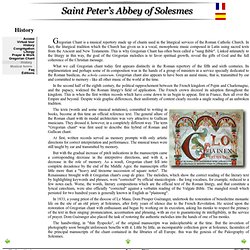
In fact, the liturgical tradition which the Church has given us is a vocal, monophonic music composed in Latin using sacred texts from the Ancient and New Testaments. This is why Gregorian Chant has often been called a "sung Bible". Gregorian Chant Benedictinos. The History Of Gregorian Chant. The Gregorian Chant is the collective name given to a whole tradition of chants that evolved in the world from the times of the Old Testament of The Christian Bible and have survived even today.
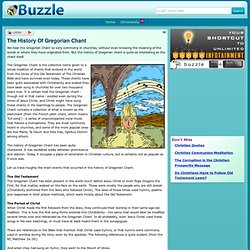
These chants have been quite associated with Christianity and indeed they have been sung in churches for over two thousand years now. It is certain that the Gregorian chant - though not in that name - existed even during the times of Jesus Christ, and Christ might have sung these chants in His teachings to people. The Gregorian Chant contains a collection of what is known as the plainchant (from the French plein chant, which means 'full song') - a series of unaccompanied vocal music that follows a monophone. They are most commonly heard in churches, and some of the more popular ones are Ave Maria, Te Deum and Dies Irae, Spiritus Domini among others. The Gregorian Chant History. The Gregorian chant is the oldest musical manifestation of the Occident and it has its roots in the songs of the old synagogues, since Jesus Christ`s times.

The first Christians and disciples of Christ, were converted Jewish that, persevering in prayer, continued to sing the psalms and songs of the Old Testament as they were used, although with other sense. Timeline: The Middle Ages. The Medieval Era (476-1450) Overview The eastern half of the former Roman empire, called Byzantium, emerged unscathed from the invasions and wars of the fifth century.
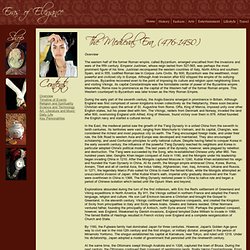
Emperor Justinian, whose reign lasted from 527-565, was perhaps the most prominent figure of his time. Justinian reconquered the western countries of Italy, North Africa and southern Spain, and in 555, codified Roman law in Corpus Juris Civilis. By 600, Byzantium was the wealthiest, most powerful and civilized city in Europe. Although Arab invasion after 632 stripped the empire of its outlying provinces, Byzantine recovered even to the point of imposing its culture and religion upon neighboring Slavs and visiting Vikings. its capital Constantinople was the formidable center of power of the Byzantine empire.